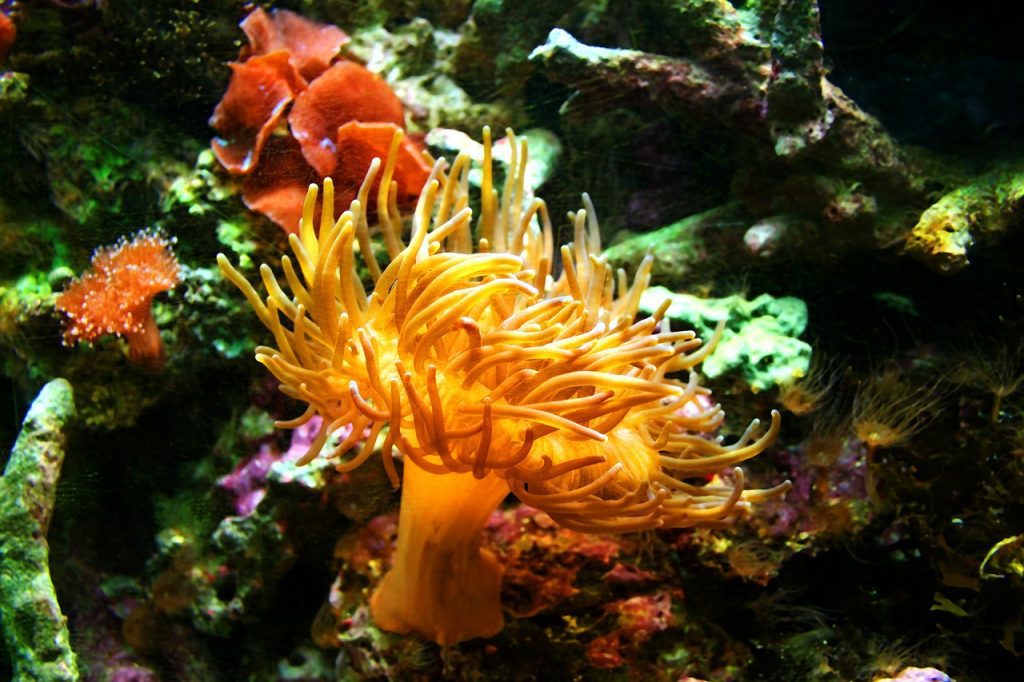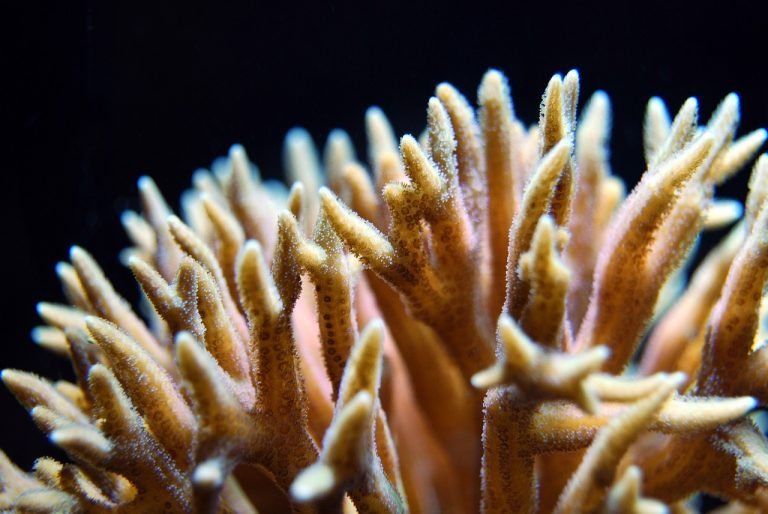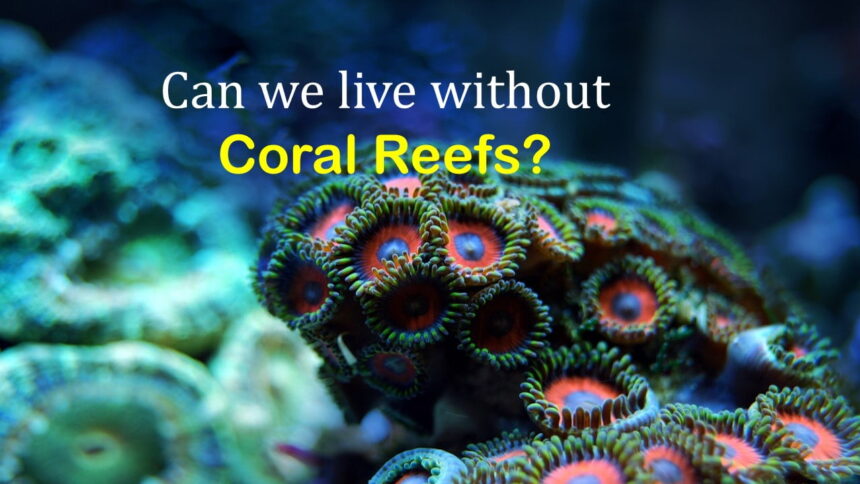Coral reefs are the most diversified marine ecosystems on the planet. Reefs are teeming with life, with almost a quarter of all ocean species relying on them for food and habitat. This is a stunning number when you consider that reefs cover just a fraction of the earth’s surface (less than one percent) and less than two percent of the ocean floor. Because of their richness, coral reefs are frequently called “rainforests of the sea.”
Coral reefs are equally vital to human survival. Their worth has been estimated to be between $30 billion and $172 billion a year, with the reefs supplying food, shoreline protection, tourism-based jobs, and even medicines.
⫸ What are coral reefs?
Coral reefs are massive underwater constructions made up of the bones of colonial marine animals. Coral species that produce reefs are hermatypic, or “hard” corals because they absorb calcium carbonate from saltwater to develop a hard, durable exoskeleton covering their soft, sac-like bodies.

A polyp is a name given to each coral. Coral polyps consume their progenitors’ calcium carbonate exoskeletons and add their own to the existing structure. The coral reef steadily grows over millennia, one little exoskeleton at a time, until it becomes a large part of the aquatic environment.
“Soft” corals are other types of coral that aren’t engaged in reef construction. According to the Coral Reef Alliance (CORAL), a nonprofit environmental organization, these corals are flexible organisms that mimic plants and trees. They include species like sea fans and sea whips.
⫸ What is Coral Reef Ecosystem?
Corals may be found in all of the world’s seas, from the Aleutian Islands off the coast of Alaska to the Caribbean Sea’s balmy tropical waters. The largest coral reefs may be found in the tropics and subtropics, where the water is clear and shallow. The Great Barrier Reef in Australia is the biggest of these coral reef systems, stretching over 1,500 miles (2,400 kilometers).
According to CORAL, there are hundreds of distinct kinds of coral. From circular, folded brain corals (called for its similarity to a human brain) to tall, graceful sea whips and sea fans that resemble complex, vibrantly colored trees or plants, coral comes in a dazzling diversity of forms and hues.
Jellyfish, anemones, Portuguese man of war, and various other gelatinous and stinging marine invertebrates are all members of the phylum cnidaria (pronounced ni-DAR-ee-uh).

Corals get their food in one of two ways. Some species use their stinging tentacles on the outside margins of their bodies to collect tiny marine creatures like fish and plankton. The majority of corals, on the other hand, rely on algae called zooxanthellae to supply energy through photosynthesis.
According to the US Environmental Protection Agency (EPA), corals and zooxanthellae share a symbiotic or mutually beneficial connection. These algae dwell inside the coral polyp’s body, photosynthesizing to provide energy for themselves and the polyps.
The algae, in turn, have a habitat and a source of carbon dioxide thanks to the polyps. The zooxanthellae also give the coral its vibrant hues; without them, most coral polyp bodies would be transparent and colorless.
●⫸ Ecological importance of Coral Reefs
Some coral species, such as brain coral, are hermaphrodites, meaning they produce both eggs and sperm. Sexual reproduction takes place during a mass coral spawning event that occurs just once a year for some species.
Coral reefs span less than 1% of the ocean floor; if all reefs were merged, they would cover around 110,000 square miles (285,000 square kilometers), roughly the size of Nevada. Despite this, they are among the world’s most productive and diversified ecosystems.
Coral reefs provide food, shelter, and breeding for around a quarter of all known marine species. Coral reefs are the principal habitat for more than 4,000 species of fish, 700 types of coral, and hundreds of other plants and animals, according to CORAL. They are sometimes referred to as “the rainforests of the sea” because of their biodiversity.
◆ According to CORAL, coral reefs are grouped into four types: fringing reefs, barrier reefs, patch reefs, and atolls.
- The most frequent type of reef is the fringing reef, which grows along coasts.
- Barrier reefs are distinguished from bordering reefs by the presence of deeper, larger lagoons that separate them from the coast.
- Patch reefs are often found on the island platform or continental shelf, growing between bordering and barrier reefs.
- Atolls are coral rings that form sheltered lagoons in the centre of the oceans, usually encircling islands that have fallen back into the sea.
●⫸ Destruction of Coral Reefs
Many ocean species rely on coral reefs as a key marine habitat. According to Stanford University’s Hopkins Marine Station, coral reefs give an estimated $30 billion in direct economic value to people globally each year through food, fisheries, and tourism. Coral reefs, on the other hand, are threatened by several factors.
Coral’s capacity to create the calcium carbonate exoskeletons they rely on for protection is being hampered by growing ocean acidification. Ocean acidification occurs when oceans absorb massive amounts of carbon dioxide released into the atmosphere via the burning of fossil fuels.
Coral reefs are also being harmed by water pollution. Agricultural pesticides and fertilizers, oil and gasoline, sewage discharge, and silt from eroding landscapes make it difficult for coral to grow, resulting in harm to the reef ecosystem‘s intricate interactions between plants, coral, and other creatures.

Coral polyps eject the zooxanthellae they rely on for sustenance when the temperatures of the world’s seas rise due to global warming. When the zooxanthellae die, the coral loses its vibrant color and just the white exoskeleton is visible; this is known as coral bleaching. According to CORAL, coral colonies that are bleached frequently perish.
Coral reef habitats, however, are in danger. Diseases, predators, and storms, for example, are all-natural hazards. Pollution, sedimentation, unsustainable fishing techniques, and climate change, which are boosting ocean temperatures and generating ocean acidification, are among humans’ other challenges. Many of these hazards can induce coral bleaching and mortality, while others inflict physical harm to these fragile ecosystems.
●⫸ Coral bleach
This occurs when coral polyps eject their symbiotic algae (zooxanthellae) in response to a stressful event. The coral polyps are mainly transparent without the algae, allowing you to see through to their white bones beneath. This gives the hair a bleached look.
✅ The good news is that coral bleaching does not always mean death. If stress circumstances are addressed on time, corals may take on new algae and recover to a healthy state. Even yet, recuperation time can range from weeks to months, and newly stressed corals are more susceptible to coral illnesses.
⛔ The bad news is that by the time we notice bleaching, it has already been happening for a while. Furthermore, the corals are beginning to suffer without the algae to give the majority of their sustenance.
●⫸ Conclusion
“Corals are significant to us for a variety of reasons,” Maurin explains. “From a practical standpoint, they can aid with the protection of coasts from storm occurrences, as well as the preservation of fisheries that are vital to many people.” Furthermore, complex chemicals discovered in coral reefs have potential in modern medicine. These are what we call ecosystem services, and replacing them would be extremely difficult and costly.

